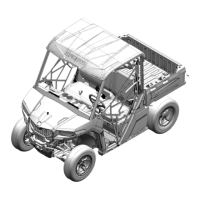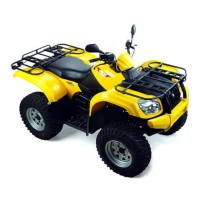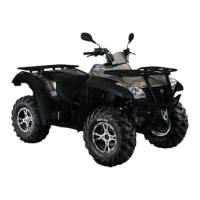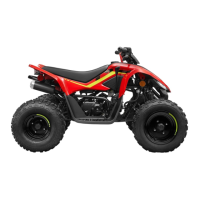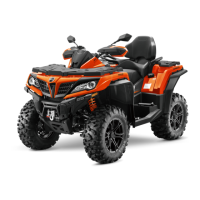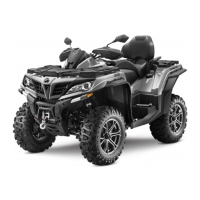Do you have a question about the CF MOTO CF600 AU-3L and is the answer not in the manual?
Details safety rules for Type I ATVs: helmet, no public roads, single rider, no drugs/alcohol.
Details safety rules for Type II ATVs: helmet, no public roads, two riders, no drugs/alcohol.
Stresses following manual instructions and warns about the deadly nature of carbon monoxide.
Warns about ATV hazards, operator responsibilities, and age limits for operation.
Highlights safety training importance and lists critical hazardous operation warnings.
Details hazards of operating without instruction or violating age recommendations.
Warns about carrying passengers on non-designated ATVs and operating on paved surfaces.
Stresses wearing protective gear and prohibits alcohol/drug use while operating.
Covers safety related to speed, stunts, maintenance checks, and proper riding posture.
Provides guidance on safe turning, sidehilling, and general terrain operation.
Details safety precautions for climbing hills, handling stalls, and operating over obstacles.
Covers safety for skidding, overloading, towing, and operating through water.
Addresses safety for reverse operation, tire usage, and vehicle modifications.
Details essential protective gear: helmet, eye protection, gloves, boots, and clothing.
Explains the operation of the 2WD, 4WD, and 4WD-LOCK modes.
Provides crucial safety warnings for handling flammable gasoline.
Explains gear selector operation and cautions against improper shifting.
Explains winch use, battery preservation, and general safety precautions.
Identifies and explains various indicators on the vehicle's dashboard (1-23).
Explains indicators for Engine RPM, Clock, LH Turn Signal, Neutral, High Beam, EFI, Oil Pressure.
Details indicators for RH Turn Signal, Drive Mode, EPS, Parking Brake, ADJ Button, Fuel Gauge.
Explains indicators for Gear Position, Coolant Temp, SEL Button, Override, and Coolant Warning.
Outlines essential procedures for the vehicle's break-in period for optimal performance.
Provides critical cautions during the break-in period regarding throttle and oil usage.
Emphasizes necessity of pre-ride inspections to prevent severe damage or injury.
Provides a step-by-step guide for starting a cold engine safely.
Offers notes on starting system limits and throttle use during speed limiting.
Explains gear shifting procedures and cautions to prevent transmission damage.
Details sequences for shifting out of park, between gears, and into reverse.
Provides guidelines for hauling cargo, emphasizing low gear, reduced speed, and load security.
Discusses balancing loads, not obstructing lights, and towing speed limits.
Explains principles for distributing loads on racks for optimal vehicle stability.
Outlines fundamental driving steps and explains turning techniques.
Details how ATVs turn and the technique for handling curves.
Explains how to operate in reverse and lists precautions.
Advises on precautions for slippery surfaces and rough terrain.
Emphasizes obstacle awareness and provides procedures for driving through water.
Lists precautions for uphill travel and handling lost forward speed.
Explains sidehilling as dangerous and provides safety precautions.
Lists precautions for downhill travel, including speed limits and weight shift.
Explains the K-turn maneuver for turning around when stranded on a hill.
Lists essential inspection items to perform before operating the vehicle.
Details inspections for air box sediment tube and radiator.
Lists maintenance tasks to be performed after the vehicle's break-in period.
Lists break-in maintenance for battery, idle, steering, brakes, and gear cases.
Lists periodic maintenance for brake pads, battery, hoses, air filter, and lubrication.
Details periodic maintenance for front/rear gear cases and the cooling system.
Lists periodic maintenance for radiator, steering, suspension, gear shift, and throttle body.
Details safety rules for Type I ATVs: helmet, no public roads, single rider, no drugs/alcohol.
Details safety rules for Type II ATVs: helmet, no public roads, two riders, no drugs/alcohol.
Stresses following manual instructions and warns about the deadly nature of carbon monoxide.
Warns about ATV hazards, operator responsibilities, and age limits for operation.
Highlights safety training importance and lists critical hazardous operation warnings.
Details hazards of operating without instruction or violating age recommendations.
Warns about carrying passengers on non-designated ATVs and operating on paved surfaces.
Stresses wearing protective gear and prohibits alcohol/drug use while operating.
Covers safety related to speed, stunts, maintenance checks, and proper riding posture.
Provides guidance on safe turning, sidehilling, and general terrain operation.
Details safety precautions for climbing hills, handling stalls, and operating over obstacles.
Covers safety for skidding, overloading, towing, and operating through water.
Addresses safety for reverse operation, tire usage, and vehicle modifications.
Details essential protective gear: helmet, eye protection, gloves, boots, and clothing.
Explains the operation of the 2WD, 4WD, and 4WD-LOCK modes.
Provides crucial safety warnings for handling flammable gasoline.
Explains gear selector operation and cautions against improper shifting.
Explains winch use, battery preservation, and general safety precautions.
Identifies and explains various indicators on the vehicle's dashboard (1-23).
Explains indicators for Engine RPM, Clock, LH Turn Signal, Neutral, High Beam, EFI, Oil Pressure.
Details indicators for RH Turn Signal, Drive Mode, EPS, Parking Brake, ADJ Button, Fuel Gauge.
Explains indicators for Gear Position, Coolant Temp, SEL Button, Override, and Coolant Warning.
Outlines essential procedures for the vehicle's break-in period for optimal performance.
Provides critical cautions during the break-in period regarding throttle and oil usage.
Emphasizes necessity of pre-ride inspections to prevent severe damage or injury.
Provides a step-by-step guide for starting a cold engine safely.
Offers notes on starting system limits and throttle use during speed limiting.
Explains gear shifting procedures and cautions to prevent transmission damage.
Details sequences for shifting out of park, between gears, and into reverse.
Provides guidelines for hauling cargo, emphasizing low gear, reduced speed, and load security.
Discusses balancing loads, not obstructing lights, and towing speed limits.
Explains principles for distributing loads on racks for optimal vehicle stability.
Outlines fundamental driving steps and explains turning techniques.
Details how ATVs turn and the technique for handling curves.
Explains how to operate in reverse and lists precautions.
Advises on precautions for slippery surfaces and rough terrain.
Emphasizes obstacle awareness and provides procedures for driving through water.
Lists precautions for uphill travel and handling lost forward speed.
Explains sidehilling as dangerous and provides safety precautions.
Lists precautions for downhill travel, including speed limits and weight shift.
Explains the K-turn maneuver for turning around when stranded on a hill.
Lists essential inspection items to perform before operating the vehicle.
Details inspections for air box sediment tube and radiator.
Lists maintenance tasks to be performed after the vehicle's break-in period.
Lists break-in maintenance for battery, idle, steering, brakes, and gear cases.
Lists periodic maintenance for brake pads, battery, hoses, air filter, and lubrication.
Details periodic maintenance for front/rear gear cases and the cooling system.
Lists periodic maintenance for radiator, steering, suspension, gear shift, and throttle body.
| Brand | CF MOTO |
|---|---|
| Model | CF600 AU-3L |
| Category | Offroad Vehicle |
| Language | English |
